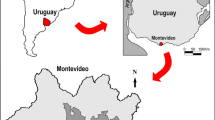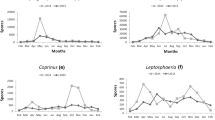Abstract
This study was carried out over a 2-year period (2001 and 2002) with the aim of identifying the fungal population in the aerosol of the Southern city of Caxias do Sul, RS, Brazil. Sampling was performed using Hirstȁ9s non-viable volumetric method. Our results show the presence of a large number of fungal spore types, a total of 41. Three groups were predominant: Deuteromycotina, Ascomycotina and Basidiomycotina. In 2001, Deuteromycotina taxa represented 44.61% of the total annual spore counts, with the largest concentration occurring in the fall (58,637 spores); in 2002, it represented 40.03% of the total annual spore counts, and the largest concentration was obtained in the summer (68,317 spores). Ascomycotina was present at the same level (24.5%) in both years of sampling, and the highest concentrations were found out in the summer (2001: 42,183 spores; 2002: 29,461 spores). Basidiomycotina represented 22.37% of the total annual spore counts in 2001, and 20.41% in 2002, with the largest concentrations found in the summer (2001: 35,988 spores; 2002: 30,212 spores). The most frequent fungi found during the study period were Cladosporium, Coprinus, Leptosphaeria, Aspergillus/Penicillium and Ganoderma. Permanent aerobiological monitoring would be necessary to detect associated environmental variations.
Similar content being viewed by others
References
Al-Subai, A. A. T. (2002). Air-borne fungi at Doha, Qatar. Aerobiologia, 18(3–4), 175–183.
Al-Suwaine, A. S., Hasnain, S. M., & Bahkali, A. H. (1999). Viable airborne fungi in Riyadh, Saudi Arabia. Aerobiologia, 15(2), 121–130.
Burge, H. A. (1986). Some comments on the aerobiology of fungus spores. Grana, 25, 143–146.
Croce, J., Silva, E .G. M., Furtado, E. L., & Queluz, T. H. A. T. (2003). Estudo dos fungos anemófilos da cidade de Botucatu e sua correlação com sensibilização em pacientes com doenças alérgicas respiratórias. Revista Brasileira Alergy Imunopatology, 26(3), 95–109.
Domínguez, E., Galán, C., Villamandos, F. E., & Infante, F. (1992). Handling and evaluation the data from the aerobiological sampling. Monografías REA, 1, 1–18.
Elvira Rendueles, M. L. B. (2001). Caracterización aeropalinológica del bioaerosol atmosférico de la ciudad de Cartagena. Tesis Doctoral. Universidad Politécnica de Cartagena. Cartagena (España).
Gambale, W., Purchio, A., & Paula, C. (1983). Influência de fatores abióticos na dispersão aérea de fungos na cidade de São Paulo. Brasilian Review Microbiology, 14(3), 204–214.
Halwagy, M. H. (1994). Fungal airspora of Kuwait City, Kuwait, 1975–1987. Grana, 33, 340–345.
Hasnain, S. M. (1993). Influence of meteorological factors on the air spora. Grana, 32, 184–188.
Henríquez, V. I., Villegas, G. R., & Nolla J. M. R. (2001). Airborne fungi monitoring in Santiago, Chile. Aerobiologia, 17(2), 137–142.
Hirst, J. M. (1952). Na automatic volumetric spore trap. Annals of Applied Biology, 39, 257–265.
Horner, W. E., Helbling A., Salvaggio J. E., & Lehrer S. B. (1995). Fungal allergens. Clinical Microbiology Reviews, 40, 161–179.
Hurtado, I., Leal, F. J., Rodriguez, A., García, E., & Alson-Haran, J. (1989). A one year survey of airborne pollen and spores in the neotropical city of Bogotá (Colombia). Allergologia et Immunopathologia, 17(2), 95–104.
Kakde, U. B., Kakde, H. U., & Saoji, A. A. (2001). Seasonal variation of fungal propagules in fruit market environment, Nagpur (India). Aerobiologia, 17(2), 177–182.
Lima, J. A., & Gadelha, W. (1983). Contaminación de hongos del aire atmosférico en la ciudad de Recife (Pernambuco-Brasil). Revista Latinoamericana de Microbiología, 25(4), 243–251.
Menezes, E. A., Trindade, E. C. P., Costa, M. M., Freire, C. C. F., Cavalcante, M. S., & Cunha, F. A. (2004). Airborne Fungi isolated from Fortaleza, Ceará, Brazil. Revista do Instituto de Medicina Tropical de Sao Paulo, 46(3), 133–137.
Mezzari, A., Perin, C., Júnior, S. A. S., Bernd, L. A. G., & Digesu, G. (2003). Os fungos anemófilos e sensibilização em indivíduos atópicos em Porto Alegre, R.S. Revista da Associacao Medica Brasileira, 49(3), 270–273.
Mitakakis, T. Z., Clift, A., & Macgee, P. A. (2001). The effect of local cropping activities and weather on the airborne concentration of alergic Alternaria spores in rural Australia. Grana, 40(4–5), 230–239.
Mitakakis, T. Z., & Guest, D. I. (2001). A fungal spore calendar for the atmosphere of Melbourne, Australia, for the year 1993. Aerobiologia, 17(2), 171–176.
Pepeljnjak S., & Šegvić M. (2003). Occurrence of fungi in air and on plants in vegetation of different climatic regions in Croatia. Aerobiologia, 19(1), 11–19.
Rivas-Martínez, S., Díaz, T.E., Fernández-González, F., Izco, J., Loidi, J., Lousa, M., & Penas, A. (2002). Vascular plant communities of Spain and Portugal. Addenda to the Syntaxonomical checklist of 2001. Part I. Itinera Geobotanica, 15(1), 1–432.
Rubulis, J. (1984). Airborne fungal spores in Stockholm and Eskilstuna central Sweden. 5th Nord. Symp. Aerobiol., pp.␣84–93.
Sabariego, S., Guardia, C. D., & Sánchez, F. A. (1999). Contribución al estudio aeromicológico de la atmósfera de la ciudad de Granada (S. España): variaciones estacionales e intradiarias. Revista Iberoamericana de Micologia, 16, 230–234.
Sáenz Laín, C., & Gutiérrez Bustillo, M. (2003). Esporas atmosféricas en la Comunidad de Madrid. Madrid, España: Documentos técnicos de Salud Pública. pp. 86.
Sen, B., & Asan, A. (2001) Airborne fungi on vegetable growing areas of Edirne, Turkey. Aerobiologia, 17(1), 69–75.
Shaheen, I. (1992). Aeromycology of Amman area, Jordan. Grana, 31, 223–228.
Author information
Authors and Affiliations
Corresponding author
Rights and permissions
About this article
Cite this article
De Antoni Zoppas, B.C., Valencia-Barrera, R.M., Vergamini Duso, S.M. et al. Fungal spores prevalent in the aerosol of the city of Caxias do Sul, Rio Grande do Sul, Brazil, over a 2-year period (2001–2002). Aerobiologia 22, 117–124 (2006). https://doi.org/10.1007/s10453-006-9022-2
Received:
Accepted:
Published:
Issue Date:
DOI: https://doi.org/10.1007/s10453-006-9022-2




